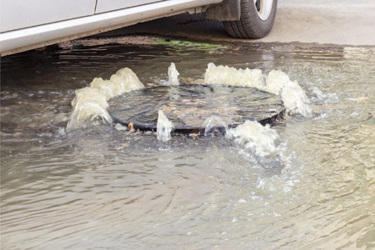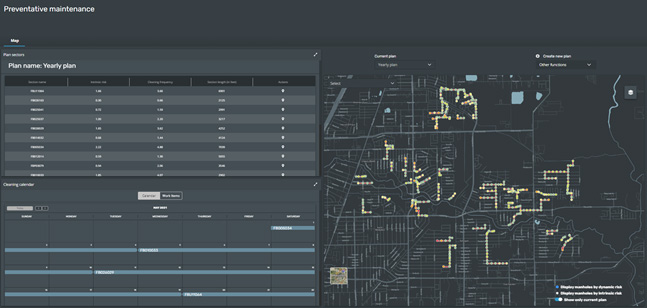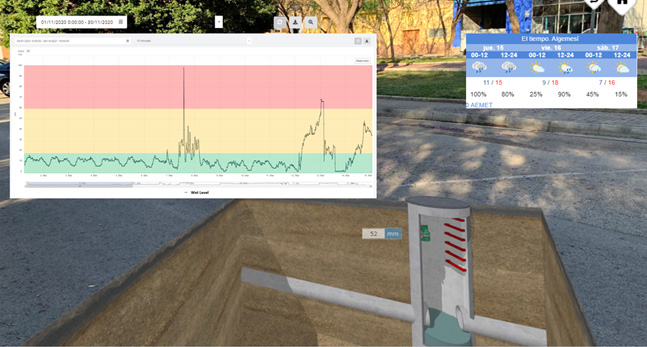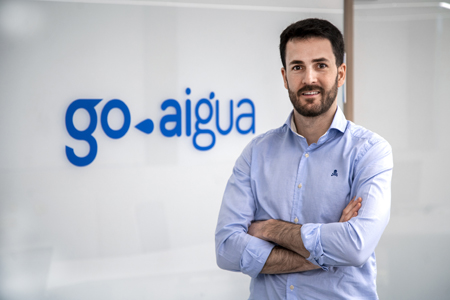Targeting Need-Based Maintenance To Reduce Sewer Overflows

Whether addressing sanitary sewer overflows (SSOs), combined sewer overflows (CSOs), or storm sewer systems, the idea of advanced strategic insight is key to minimizing damage or public health risks caused by overflow events. Here is a look at how concentrating on the most at-risk areas first — with a focus on overflow prevention — can offer better control for wastewater utilities of all sizes (Figure 1), as it is doing for the city of Houston, TX.

Photo courtesy of GoAigua
Figure 1. Having digital readings, trending graphics, alarm-level settings, and GIS locations visible on a single screen makes it easier for sewer system operators to monitor collection system status at a glance and set maintenance priorities based on the most critical areas of infrastructure performance.
Why It’s Time To Rethink Wastewater Monitoring
Here are four reasons for taking a more active role in monitoring and forecasting wastewater collection system performance as a way of controlling problematic overflow events:
- Customer Behavior. Increased use of ‘flushable’ disinfecting wipes related to the pandemic is just one example of where increased risk of clogs and obstructions can impact wastewater collection system overflows.
- Regional Growth. Adding new service connections upstream of existing collection mains changes the dynamics of a system — especially in the highest-volume and lowest-lying areas.
- Climate Influence. Regions experiencing more frequent or more extreme weather events can see increased impacts from inflow and infiltration (I&I) (Figure 2).
- Aging Infrastructure. Cumulative stresses on underground collection system infrastructure (e.g., shifting ground and stormwater erosion) can increase infiltration. That and the accumulation of clogging obstructions over time increases the potential for overflow conditions. Being able to identify even small changes in system behavior can provide timely insights for adjusting preventive maintenance activities.

Photo courtesy of GoAigua
Figure 2. Being able to identify sudden isolated rises due to I&I during wet weather events enables a wastewater utility to prioritize repair efforts based on the volume of the influx and its risk implications.
Strategies For Reducing Sewer Overflows
One important aspect in reducing the risk of SSOs/CSOs is having the ability to analyze historic and real-time flow data to understand changing performance characteristics in time to predict optimum times for sewer cleaning and maintenance. Key factors supporting such a predictive maintenance approach, instead of simply a scheduled maintenance or reactive maintenance approach, include:
- Hydraulic Modeling. Understanding how a wastewater collection system should behave — based on infrastructure components and capacity, changes in elevation, flow characteristics, etc. — and being able to pinpoint where it does not, goes a long way toward forecasting and preventing potential problems. It also enables testing of different scenarios from piping changes to valve and pump operation.
- Scalable Infrastructure Profiling. Classifying the capacity of collection system piping, catch basins, lift stations, etc. in a digital system and comparing current and anticipated flows at specific points provides the basis for accurate profiling, analysis, and forecasting. It also aids in prioritizing the quantity and placement of sensors for systems with millions of sewer connections down to those with fewer than 10,000 connections
- Condition-Based Calculations. Knowing both system capacity and system reaction to existing flows at specific locations helps in identifying increasingly restricted segments for targeted cleaning and maintenance. It can also help in forecasting a potential need to redirect flows based on rising sewer levels during a specific event.
- Industrial Internet of Things (IIoT) Data Collection Technology. Using the hydraulic model to optimize placement of real-time IIoT sensors makes the most valuable use of limited funds for monitoring differences in actual performance vs. theoretical targets.
- Leveraging Past Experience. Having the ability to integrate GIS-layer historical data from spreadsheets or SCADA systems with real-time data collected from IIoT sensors provides more insight for system operators to formulate responses to new challenges before they occur.
- Predictive Analytics And Scheduling. The right smart water platform can satisfy the needs and budgets of utilities across an extreme range of sizes — from the simplest analysis of trend detection and alarm setting to using full-scale machine learning to forecast future events up to 72 hours in advance. Even smaller systems can get a good analytical overview for maintenance scheduling from as few as a dozen sensors positioned to complement the hydraulic model. Having the option to add digital twin analytical capabilities increases opportunities to understand past events and test the impacts of potential responses to existing or new challenges.
Case In Point: Houston, TX
Here is how hydraulic modeling, strategic sensor placement, and a preventive maintenance mindset are working for Houston Public Works (HPW). As a 2.3-million-resident city spanning 665 square miles of flat terrain, Houston has historically experienced SSO problems. In addition to planning for structural upgrades (i.e., replacement of more than 100 lift stations and more than 35 miles of force-main sewers), the city is also focused on issues related to fats, oils, and grease (FOG) as well as disinfecting wipes, two known sources of blockages.
To achieve its goals, HPW is using the analytical capabilities of the GoAigua smart water platform that evolved from hands-on utility experience and has global applications and success in creating strategic, comprehensive approaches to wastewater management (Figure 3). The same basic principles being implemented in Houston can be applied by wastewater utilities of any size.
- Develop A Risk-Based Preventive Maintenance Plan. The utility is changing from calendar-based scheduling to risk-based scheduling, down to the asset level. The approach uses multiple data sources — historical SSO records, last preventive/reactive work orders, GIS information, mathematical modeling of the collection system, etc. — to calculate cleaning schedules. HPW is aiming to minimize environmental impacts and save money by allocating resources to the highest-risk locations.
- Maximize Wet-Level Sensor Investments. Whether estimating how many sensors will be required to achieve targeted levels of SSO/CSO reduction or looking at optimal locations for a limited number of sensors, using proven algorithms to calculate hydraulic influences throughout a chain of manholes helps optimize those decisions. This enables a utility to maximize ROI on the capital investment for critical data collection.
- Use Predictive Analytics For Early Detection Of SSOs. Being able to identify SSO risk calculated from anomalies in sensor data across multiple levels — every sewershed, every asset, every sensor-equipped manhole — enables HPW to focus on more timely cleaning and maintenance decisions.
The bottom-line results from these tactics are helping HPW to identify and minimize the most likely SSO/CSO events with the most efficient capital investment in data collection sensors and networks.

Figure 3. While HPW is looking to place up to 3,000 level sensors throughout their sewer network over the next few years, priorities for the first wave of installations were established by identifying the highest-risk locations based on key criteria calculated in the utility’s new analytics system.
 Pablo Calabuig is the CEO of GoAigua Inc., the U.S. subsidiary of the Spanish-based smart water company that is transforming utilities into more intelligent, more proactive, and more resilient organizations through digital transformation. He graduated in Civil and Environmental Engineering from the University of Valencia and UC Berkeley. After working in the city of Valencia’s water utility, he joined the global consultancy firm McKinsey & Company, focusing on digital transformation, IoT, and telecommunications across the USA and Latin America. Since 2019 he has been leading GoAigua’s digital expansion in North America.
Pablo Calabuig is the CEO of GoAigua Inc., the U.S. subsidiary of the Spanish-based smart water company that is transforming utilities into more intelligent, more proactive, and more resilient organizations through digital transformation. He graduated in Civil and Environmental Engineering from the University of Valencia and UC Berkeley. After working in the city of Valencia’s water utility, he joined the global consultancy firm McKinsey & Company, focusing on digital transformation, IoT, and telecommunications across the USA and Latin America. Since 2019 he has been leading GoAigua’s digital expansion in North America.
